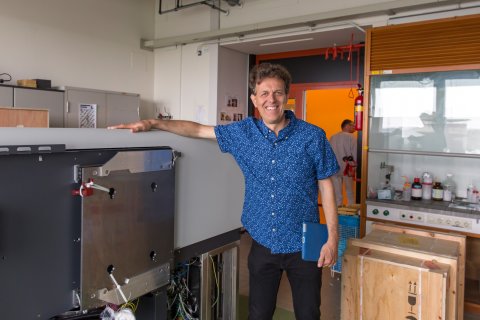A special new isotope device for the IMAU
Third instrument in the world can select the masses a thousand times more accurately than existing instruments

Wednesday 8 June was an exciting day for the Institute for Marine and Atmospheric research Utrecht (IMAU). A new, large isotope instrument was delivered. The largest part of the instrument had to be hoisted to the sixth floor of the Buys Ballot Building with a crane. The device has now been installed, and the first measurements can now be made.

An important moment
Five lorries arrived at the Buys Ballot Building from Bremen on 8 June. It was possible to transport most parts of the device to the laboratory via the lift, but the largest part had to be hoisted through the window of the sixth floor in a spectacular fashion. Thomas Röckmann watched with bated breath from below: "This is an important moment for our institute. We are the third organisation in the world to use this instrument."

A thousand times more sensitive
The instrument, a ThermoFisher MAT 253 Ultra developed in California, is a mass spectrometer with which the ratio of different isotopes (atoms of the same element but with different mass) can be measured extremely accurately. "This new instrument can select the masses a thousand times more accurately than existing instruments", according to Röckmann.

Combination of techniques
The device has various applications. Molecules that nearly have the same mass - but, due to the isotopes, not exactly the same - can be separated from one another using electrical and magnetic fields. Furthermore, the instrument is extremely sensitive thanks to the use of detectors. This combination of separating power and detection enables the device to measure multiple heavy isotopes. Until now, it was only possible to measure molecules with one heavy isotope.

Greenhouse gas cycles
By conducting measurements on the molecules in this manner, it is possible to determine their formation temperature, for example. This is useful for climate and geological research. Röckmann’s research group is particularly interested in using the new isotope signals in atmospheric research. The origin of greenhouse gases and other pollutants in the atmosphere can now be better determined; gases such as carbon dioxide, methane, nitrous oxide, ozone, nitrogen and carbon monoxide. Röckmann: "We want to gain more insight into gas cycles, such as the production and degradation processes. From an international perspective this is important research, especially considering additional insight could help us to reduce the emission of greenhouse gases."

New theories
A technician from ThermoFisher spent a week here testing and calibrating the new instrument. Hopefully, Röckmann can really start taking measurements soon. "It is certainly very exciting. We can use these measurements to investigate processes that were previously not accessible."
The ThermoFisher MAT Ultra received a large amount of funding from the Zwaartekrachtproject NESSC, supplemented with funding from Utrecht University.

